Ein Spaziergang durch Geschichte, Natur und stille Momente im Herzen Bayerns.
A walk through history, nature, and quiet moments in the heart of Bavaria.
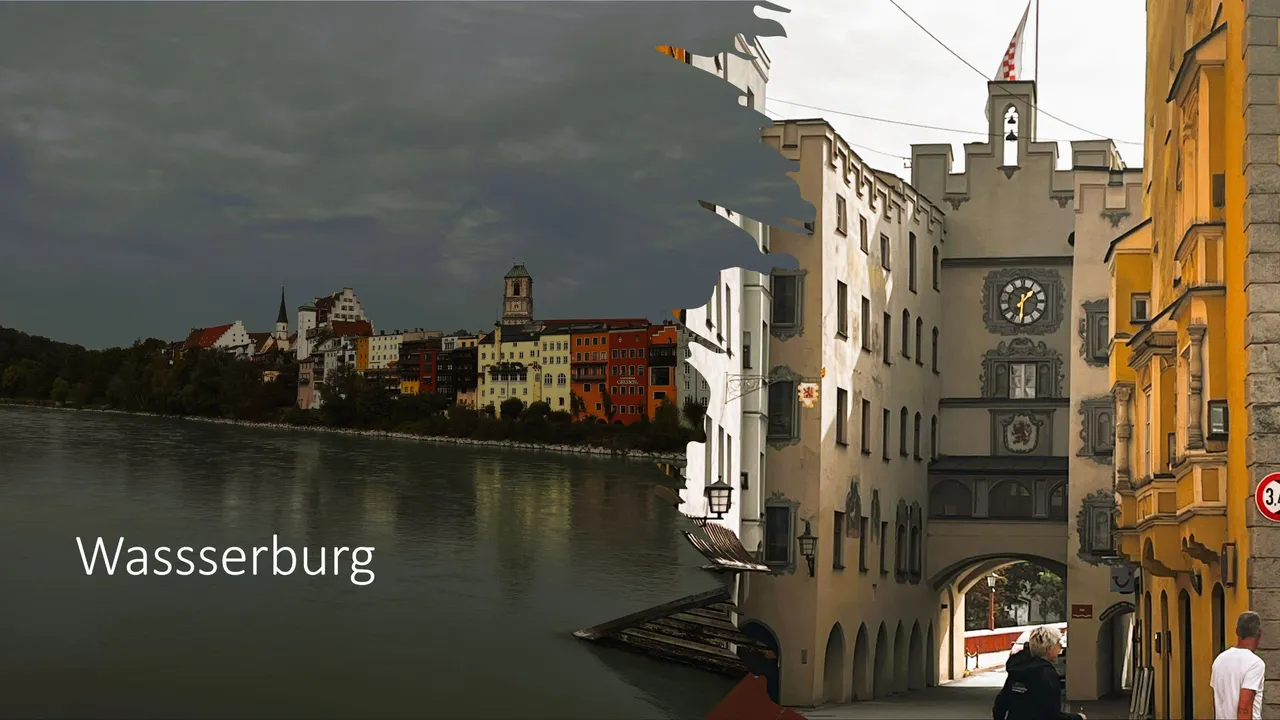
🔸Wasserburg am Inn – einst wichtige Handelsstadt, geschützt vom Fluss und bewacht vom Brucktor. Zwei Ansichten, eine Geschichte: vom Ankommen, Durchreisen und Verweilen.
🔸Wasserburg am Inn – once a key trading town, protected by the river and guarded by the Brucktor. Two views, one story: of arrivals, transitions, and moments of stillness.
Ein paar Tage unterwegs in Bayern – mit dem Campervan und offenem Blick für neue Eindrücke. Unser Stellplatz lag direkt am Ortseingang von Wasserburg am Inn, auf dem Gelände des Freizeit- und Erlebnisbads BADRIA. Von dort aus waren es etwa 1,5 Kilometer zu Fuß in die Altstadt – wahlweise über das grün durchzogene Wuhrtal mit rund 50 Höhenmetern, oder wie wir es auf dem Hinweg machten: gemütlich etwa drei Kilometer durch die Stadt. Der Rückweg führte uns dann doch über das Wuhrtal – ein stilles Tal mit alten Bäumen, feuchtem Waldboden und dem leisen Rauschen eines Bachs, das fast wie ein Atemzug der Stadt wirkt.
We spent a few days on the road in Bavaria – traveling in our campervan with an open mind and eyes wide for new impressions. Our campsite was right at the entrance of Wasserburg am Inn, located next to the BADRIA leisure and spa center. From there, the old town was about a 1.5-kilometer walk through the green Wuhrtal valley with around 50 meters of elevation – or, as we chose on the way in, a relaxed 3-kilometer stroll through town. On the way back, we did take the Wuhrtal route – a quiet trail lined with old trees, damp forest floor underfoot, and the soft murmur of a stream, like the town’s own breath.
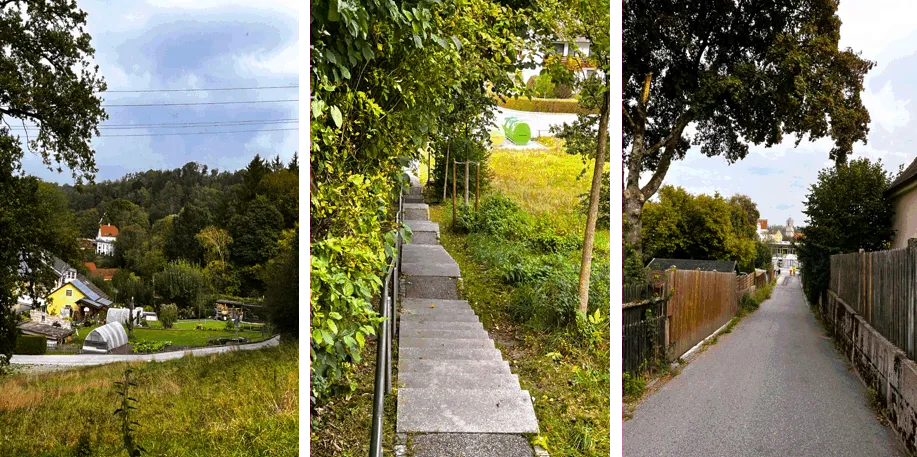
🔸Ein Weg hinab durch das Wuhrtal: zwischen alten Gärten, feuchten Stufen und dem leisen Rauschen des Talwinds. Seit jeher ein Zugang zur Stadt und zum Wechselspiel von Nähe und Weite.
🔸A path down through the Wuhrtal: past old gardens, damp steps, and the quiet rustle of valley air. A timeless gateway to the town and to the rhythm between closeness and open space.
Die Altstadt von Wasserburg empfing uns mit ihrem ganz eigenen Zauber: verwinkelte Gassen, bunte Fassaden, Geschichte auf Schritt und Tritt. Schon beim Überqueren der Roten Brücke spürt man das Besondere dieses Ortes. Früher stand hier eine hölzerne Zugbrücke vor dem Brucktor, die mehrmals erneuert wurde. Der heutige Bau orientiert sich an der Optik des 19. Jahrhunderts – ein schönes Beispiel dafür, wie alte Strukturen neu interpretiert werden können, ohne ihren Charakter zu verlieren.
Wasserburg’s old town greeted us with a charm all its own: winding alleyways, colorful facades, and history at every step. Crossing the Red Bridge felt like entering another world. In the past, a wooden drawbridge stood here, just in front of the Bruck Gate. It was rebuilt several times, and today’s version closely resembles the look it had in the 19th century – a beautiful example of how old structures can be preserved in spirit without losing their authenticity.
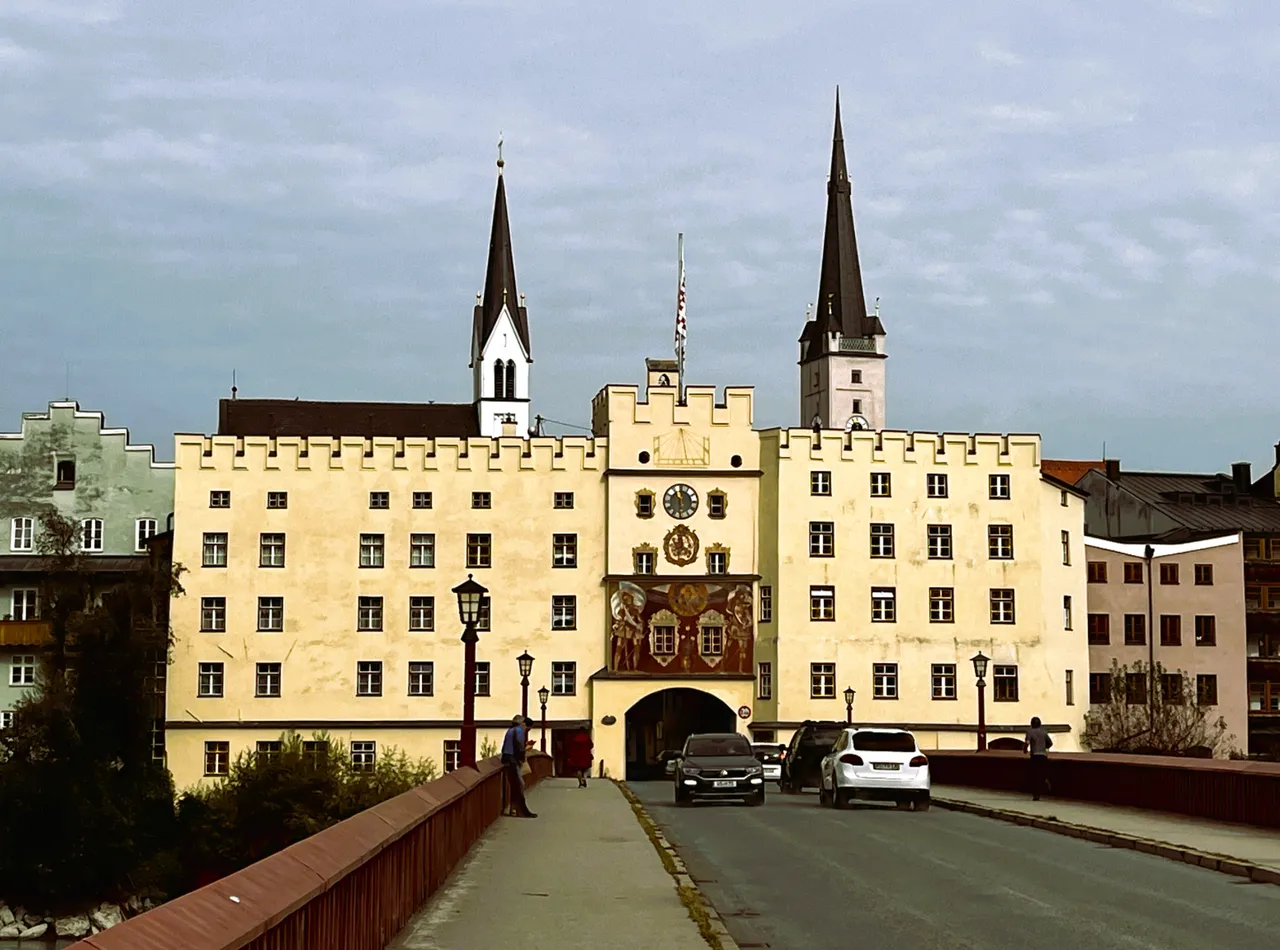
🔸Das Brucktor – einst Zollstelle, heute Durchgang. Zwischen Kirchtürmen, gelbem Mauerwerk und grauem Himmel fließt der Alltag hindurch. Geschichte steht still, während die Welt weiterfährt.
🔸The Brucktor – once a customs gate, now a passageway. Between church spires, yellow stonework, and grey skies, everyday life moves on. History stands still while the world keeps going.
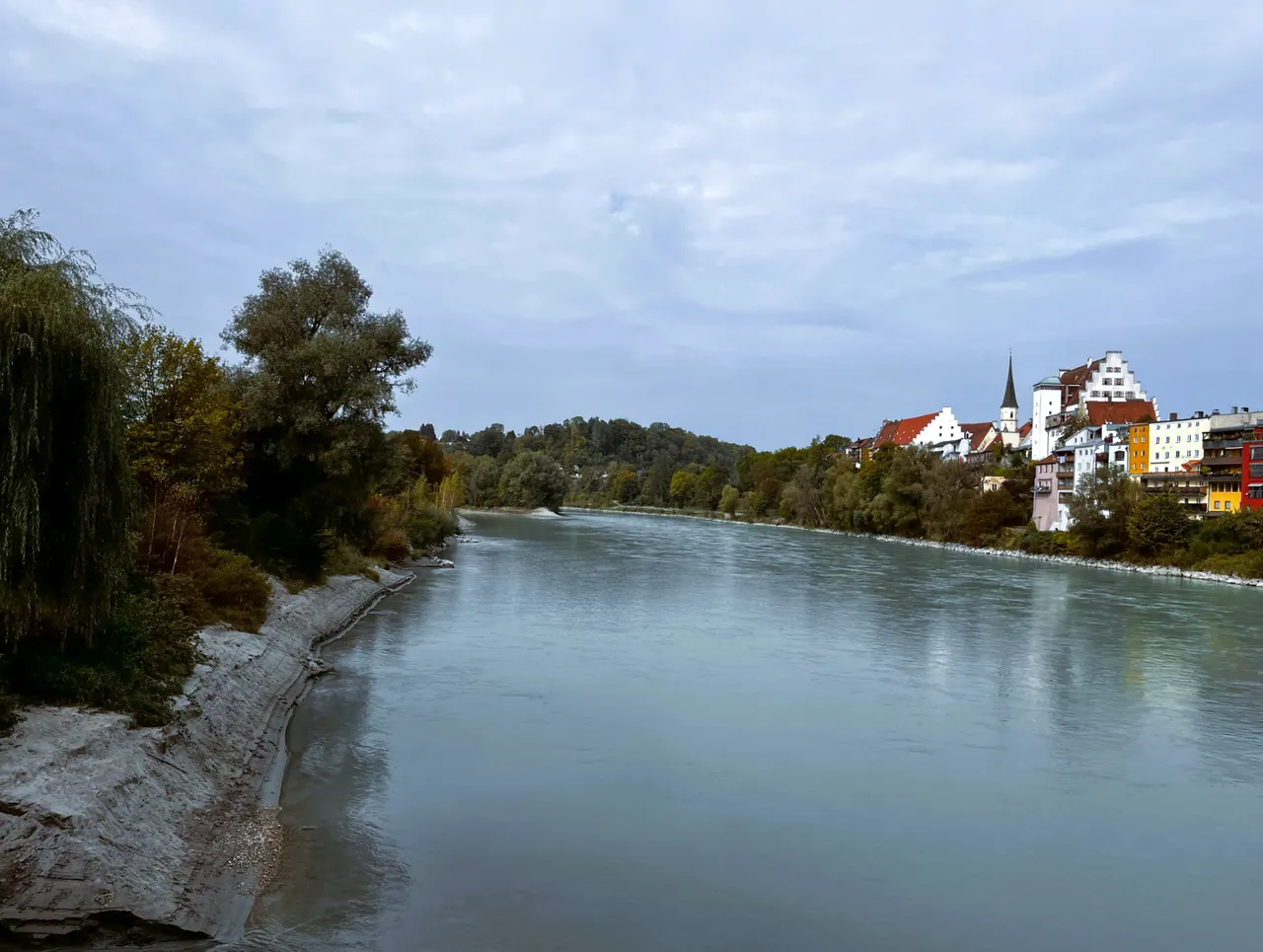
🔸Links das grüne Ufer, rechts die Altstadt – Wasserburg liegt wie eingefasst in die große Schleife des Inns. Eine Stadt, die sich dem Fluss anvertraut hat, als hätte er ihr den Platz zugewiesen.
🔸 Green banks to the left, the old town to the right – Wasserburg rests within the wide curve of the Inn. A town that seems to have trusted the river to choose its place.
Wir schlenderten vorbei am Rathaus und der Frauenkirche, einem frühgotischen Bau mit ruhiger Würde, weiter zum Kernhaus, das mit seiner reich verzierten Rokoko-Fassade auffällt – eines der schönsten Beispiele dieser Art in Süddeutschland. Das Kernhaus stammt aus der Zeit um 1735/40 und trägt noch heute den Namen der Wasserburger Patrizierfamilie Kern. Jedes Detail der stuckierten Außenfassade erzählt von einer Epoche, in der das Repräsentative fast kunstvoll ins Verspielte kippte.
We wandered past the town hall and the Church of Our Lady, a quiet, early Gothic building full of gentle presence. Then on to the Kernhaus, with its richly decorated Rococo facade – considered one of the most beautiful in southern Germany. Built around 1735/40, it still carries the name of the local patrician Kern family. Every detail of its stucco exterior tells of a time when architectural flair danced right on the edge of playful opulence.
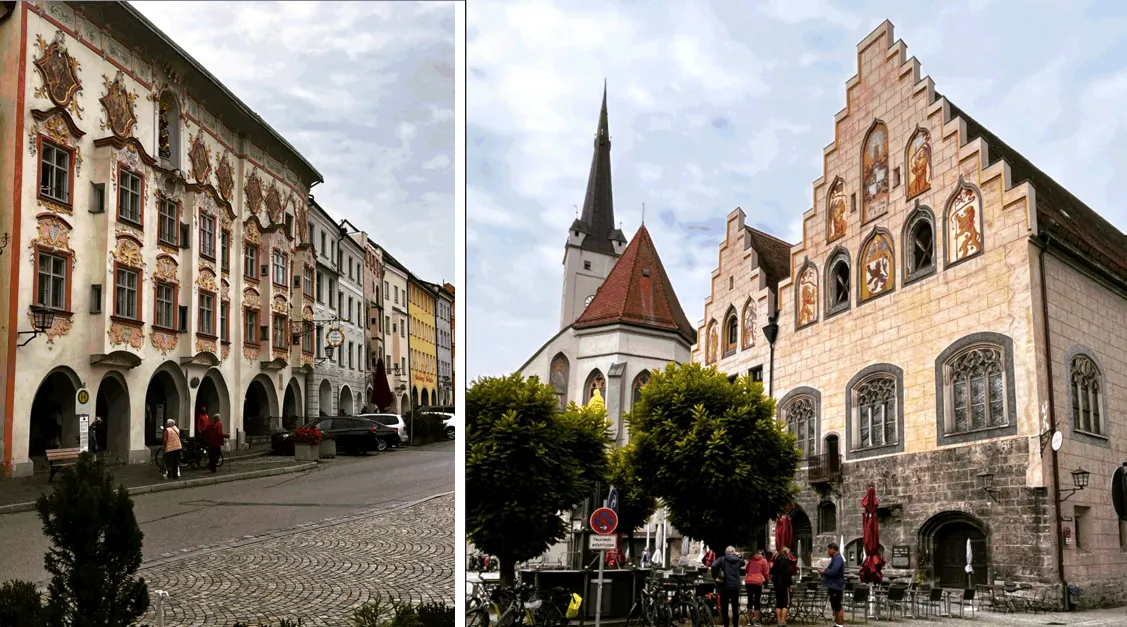
🔸Gotik, Barock und Bürgerstolz – in der Altstadt verdichten sich Jahrhunderte. Das Rathaus, die Frauenkirche und das Kernhaus erzählen vom Wandel einer Stadt, die ihre Schönheit nie laut zeigt, aber immer spürbar macht.
🔸Gothic lines, baroque curves, and civic pride – centuries converge in the old town. The town hall, Frauenkirche, and Kernhaus reflect a city that never shouts its beauty, yet always lets it be felt.
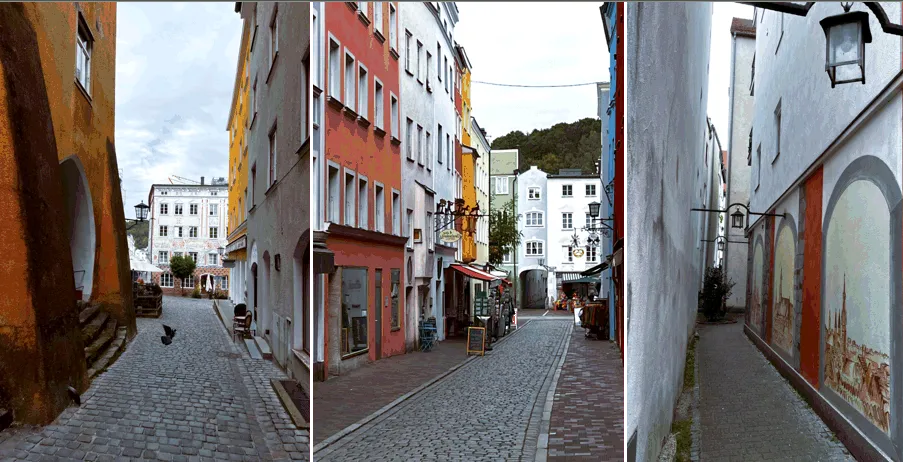
🔸Zwischen schmalen Gassen und farbenfrohen Fassaden scheint die Zeit langsamer zu laufen. Manche Mauern tragen Bilder, andere bloß das Licht – doch alle erzählen von einem Ort, der mit jedem Schritt lebendig bleibt.
🔸Among narrow lanes and colourful facades, time seems to slow down. Some walls wear paintings, others just the light – yet all speak of a place that stays alive with every step.
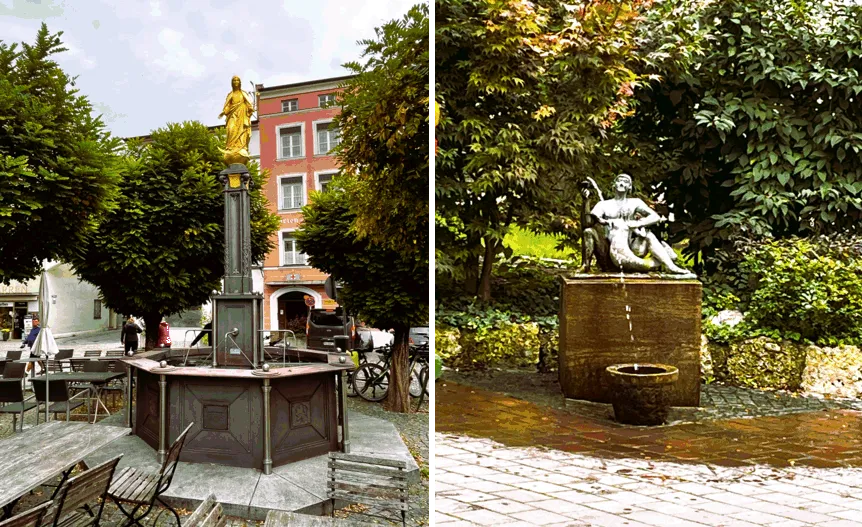
🔸Zwischen Bäumen und Fahrrädern wacht eine Figur über den Platz – halb Heilige, halb Wassernixe. Ihr Brunnen flüstert Geschichten, während das Wasser still in den Eimer fällt.
🔸Between trees and bicycles, a figure keeps watch over the square – part saint, part water nymph. Her fountain whispers stories as the water quietly spills into the bucket below.
Nicht weit davon entfernt: der Rote Turm – still, etwas abseits, und doch wie ein Ausrufezeichen in der Silhouette der Stadt. Wir verloren uns in den kleinen Straßen, ließen uns treiben, atmeten Wasserburg ein.
Not far from there stands the Red Tower, quiet and slightly off the path – like a punctuation mark in the town’s skyline. We let ourselves drift through the streets, open to whatever the day would bring.

🔸Ein stilles Tor mit Geschichte: links die hölzerne Treppe, rechts das rote Haus – dazwischen Kopfsteinpflaster, das noch klingt, wenn jemand hindurchgeht. Das Rote Tor bleibt: Beobachter und Übergang zugleich.
🔸A quiet gate with a past: wooden stairs to the left, a red house to the right – cobblestones in between, echoing softly under passing steps. The Red Gate endures: both witness and passage.
Auch wenn wir sie nicht besucht haben, verdienen die berühmten Bierkatakomben eine kurze Erwähnung – ein faszinierendes Relikt aus den Zeiten, als unterirdische Gänge zum Kühlen der Fässer genutzt wurden. Allein die Vorstellung davon – kühle Stille unter der Erde, das Grollen der Fuhrwerke darüber – lässt Geschichte lebendig werden.
Even though we didn’t visit them, the city’s famous beer catacombs are worth mentioning – a fascinating reminder of the times when underground tunnels were used to keep barrels cool. Just imagining the cool silence below and the rumble of wagons above makes the past feel close.
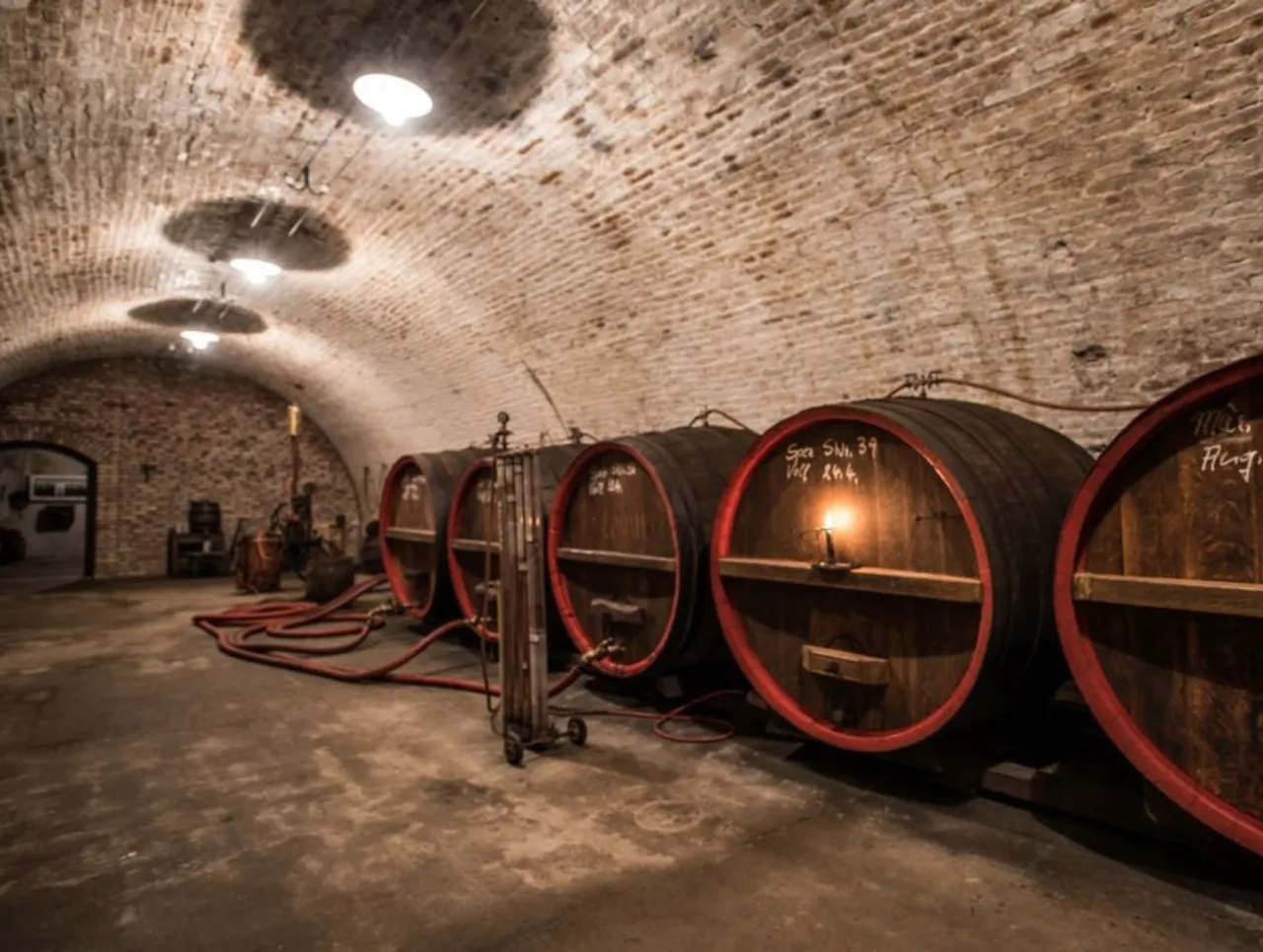
🔸Screenshot (Source) Unter der Stadt: einst Lagerort für das flüssige Gold der Region. Die Bierkatakomben erzählen von Handwerk, Kühlung ohne Strom – und vom Wert des Unsichtbaren.
🔸Beneath the town: once a vault for the region’s liquid gold. The beer catacombs speak of craft, cooling without power – and the quiet value of what lies unseen.
Kulinarik in der Altstadt
Culinary Moments in the Old Town
Nach dem Bummel lockte uns der Duft nach Gebratenem und Frischem schließlich ins Bistro Stechl Keller, das mit regionalen Gerichten aufwartet – liebevoll zubereitet und mit spürbarem Bezug zur Region. Die Bedienung empfahl uns freundlich ein Gericht mit Zutaten aus der Umgebung. Es dauerte ein wenig, bis wir einen Platz im Freien ergattern konnten – aber das Warten lohnte sich. Die Atmosphäre im kleinen Innenhof, das leise Klirren der Gläser, das Gespräch am Nebentisch über alte Zeiten – all das machte das Essen zu mehr als nur einer Mahlzeit.
After our walk, we were drawn in by the smell of something fresh and savory – and ended up at the Stechl Keller Bistro, known for its regional cuisine. The waitress kindly recommended a dish made with ingredients from the local area. It took a little while to get a table outside – it was clearly a popular spot – but the wait was worth it. The atmosphere in the small courtyard, the clinking of glasses, and a quiet conversation at the next table about days gone by made it more than just a meal.
Wasserburg ist mehr als ein hübsches Städtchen mit mittelalterlichem Kern. Es ist ein Ort, an dem Geschichte sichtbar bleibt, ohne sich aufzudrängen. Wo man spürt, dass Wandel möglich ist, ohne dass die Wurzeln gekappt werden müssen. Ich denke oft an solche Orte – besonders dann, wenn in mir selbst etwas im Umbruch ist. Vielleicht suchen wir gerade deshalb solche Zwischenräume auf: kleine Städte, stille Gassen, den Weg über das Wuhrtal. Weil sie uns daran erinnern, dass Entwicklung nicht laut sein muss. Dass es Brücken braucht – nicht nur zwischen Uferseiten, sondern auch zwischen den Teilen in uns, die noch unterwegs sind. Wasserburg is more than just a pretty town with a medieval core. It’s a place where history is visible without being overwhelming. Where you feel that change is possible without having to cut your roots. I often think of places like this – especially when something inside me is shifting. Maybe that’s why we seek out these in-between places: small towns, quiet paths, the trail through the Wuhrtal. Because they remind us that growth doesn’t have to be loud. That we need bridges – not just between riverbanks, but between the parts of ourselves that are still on their way. Am Ortsrand von Wasserburg, zwischen Erlebnispark und sanften Bauminseln, liegt ein gebührenfreier Stellplatz für bis zu zwölf Mobile – aufgeteilt in einen kleineren Bereich mit vier Plätzen direkt am Großparkplatz sowie einen erweiterten Teil, der offiziell acht Plätze bietet, aber großzügig genug wirkt, um auch mehr Fahrzeuge aufzunehmen. Der Untergrund ist geschottert und befestigt, stellenweise angenehm schattig. Die Lage ist ruhig, mit direktem Anschluss an Wander- und Radwege. Ein Spaziergang ins Zentrum dauert etwa 30 Minuten, alternativ gibt es einen ÖPNV-Anschluss direkt am Platz. Versorgung gibt es nur eingeschränkt: Strom ist verfügbar (Preise variieren je nach Säule), auf Frischwasser oder Entsorgung muss man allerdings verzichten. Hunde sind willkommen, der maximale Aufenthalt ist auf drei Nächte begrenzt. On the outskirts of Wasserburg, nestled between a leisure park and gentle clusters of trees, lies a free motorhome site for up to twelve vehicles. It’s divided into a smaller area with four spots next to a large public parking lot, and a newly expanded section offering eight more — though the space feels generous enough for a few additional campers. The ground is gravelled and level in most places, with some shaded spots beneath the trees. It’s a peaceful location, directly connected to cycling and hiking trails. The town center is about a 30-minute walk away, or you can hop on a bus from the nearby public transport stop. Facilities are minimal: electricity is available (prices vary by socket), but there’s no fresh water or disposal service. Dogs are welcome, and the maximum stay is limited to three nights. 🟠 About me: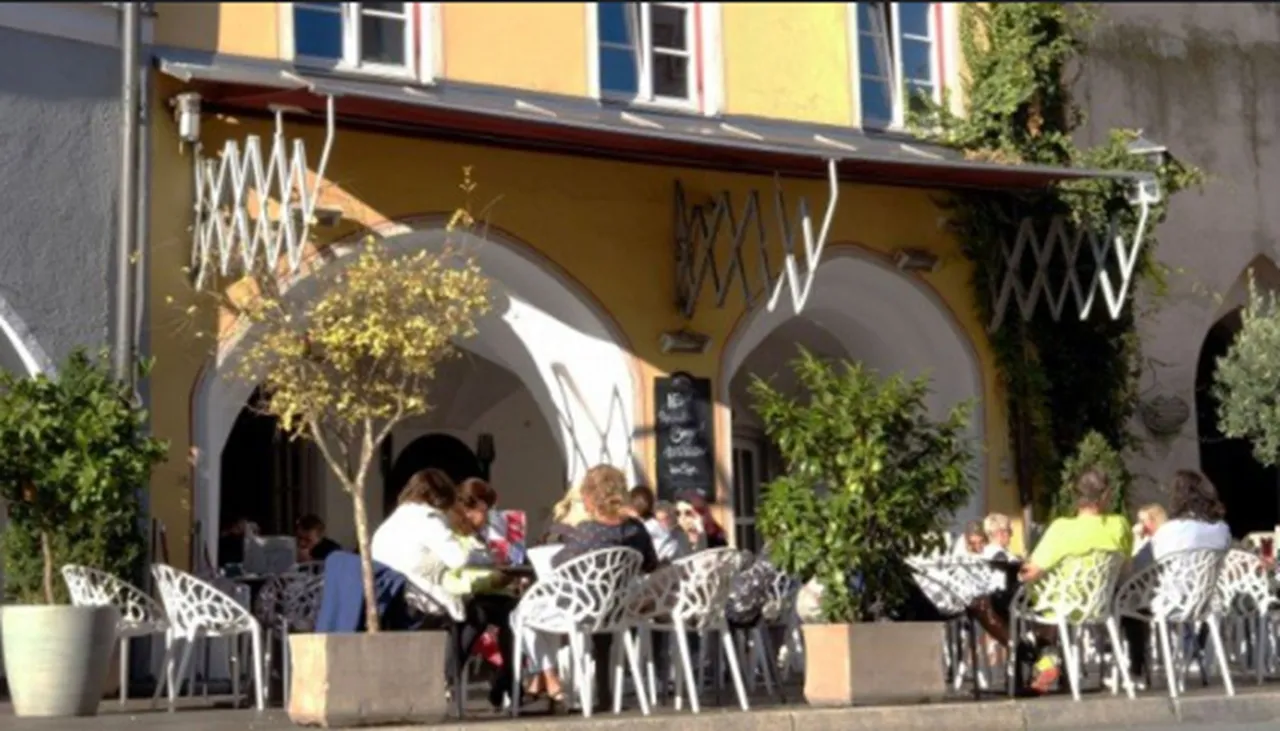
🔸(Screenshot Source) Gut besucht, warmherzig bewirtet – im Stechl Keller schmeckt die Region. Zwischen Gesprächen, Gläserklang und einem Hauch Geduld wird aus einer Mahlzeit ein Moment.
🔸Busy, welcoming, unmistakably local – at Stechl Keller, the region is served with heart. Between conversations, clinking glasses, and a touch of patience, a meal becomes a moment.
Rückblick
Looking Back
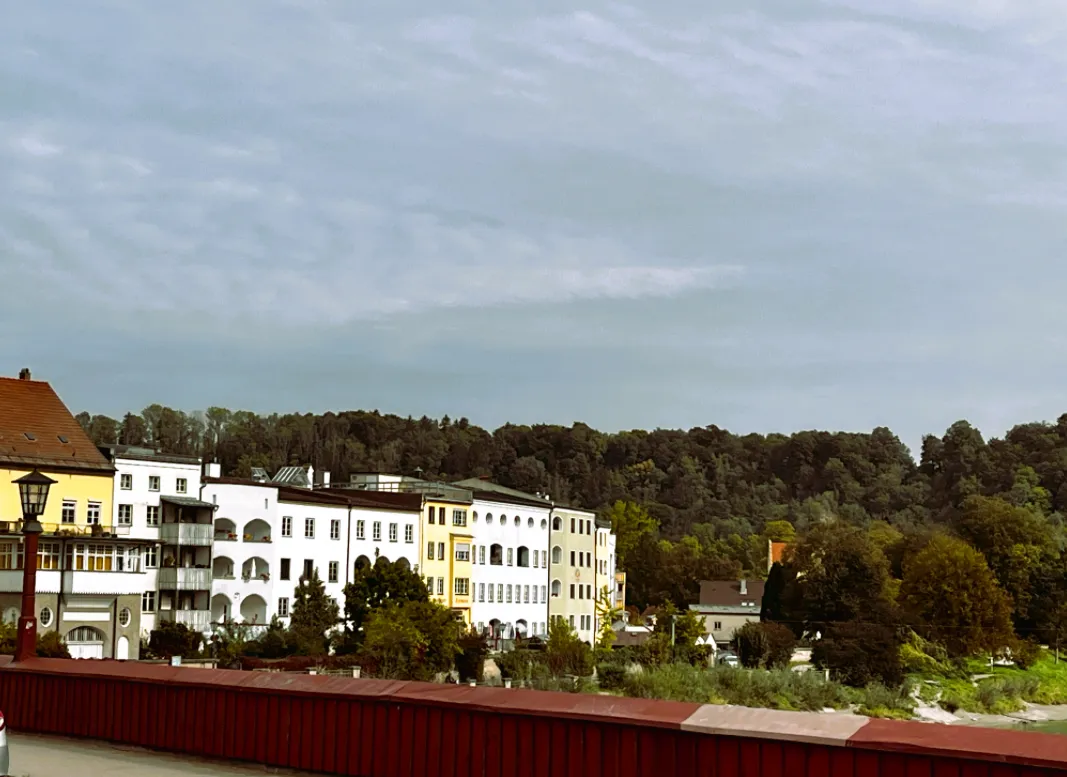
🔸Ein ruhiger Blick auf das Altstadtufer, wo sich Geschichte, Natur und Stille zu einem Moment verweben. Hier trifft das Fließen des Inns auf die Zeit, die sanft weitergeht.
🔸A quiet view of the old town’s riverbank, where history, nature, and silence weave into a single moment. Here, the flowing Inn meets time, gently moving forward.
Wohnmobilstellplatz am Badezentrum Badria
Motorhome site at the Badria bathing center

🔸Zwischen Bäumen, Schotter und Weitblick: der Stellplatz am Ortsrand – schlicht, ruhig und überraschend großzügig. Ein guter Startpunkt für kleine Fluchten ins Grüne oder einen Stadtspaziergang Richtung Altstadt.
🔸Between trees, gravel, and open skies: the motorhome site on the town’s edge – simple, quiet, and surprisingly spacious. A fitting base for short escapes into nature or a walk into the old town. Übersicht Wohnmobilstellplatz am Badezentrum Badria
Overview Motorhome site at the Badria bathing center
Adresse
AddressAlkorstraße 14, 83512 Wasserburg am Inn Internet https://www.wasserburg.de/de/tourismus-freizeit/gastgeber/camping-und-wohnmobil
https://www.wasserburg.de/en/sightseeing/impressionsPhone / Email +49 8071 10522
touristik@wasserburg.deGeeignet für:
Suitable for:Wohnmobile, auch über 8m
motorhomes, even over 8mFür Wohnwagen geeignet:
Suitable for caravans:Ja
YesAnzahl Stellplätze:
Number of parking spaces:12 Öffnungszeiten:
Opening times:January to December Max. Übernachtungsdauer:
Max. Overnight stay:3 Stellplatzgebühr:
Pitch fee:Kostenlos
Free of chargeStrom:
Electricity:0,25 - 0,50 € / kWh Frischwasser:
Fresh water:nicht vorhanden
not presentEntsorgung Grauwasser:
Disposal of grey water:nicht vorhanden
not presentEntsorgung Schwarzwasser:
Disposal of black water:nicht vorhanden
not presentHunde:
Dogs:erlaubt
allowedToiletten:
Toilets:nicht vorhanden
not presentDusche:
Shower:nicht vorhanden
not presentWLan: nicht vorhanden
not presentBezahlen:
Paying:Münzen für Strom
Coins for electricitySonstiges:
Other:🔸 Zum Wasserburger Frühlingsfest steht der Platz leider nicht zur Verfügung
- Stellplätze 4 Alte + 8 Neue. Unterschiedliche Strompreise!
🔸Unfortunately the pitch is not available for the Wasserburg Spring Festival
-Pitches 4 old + 8 new. Different electricity prices!Follow this link to the overview of my visited RV parks
I enjoy writing travel stories – but also about life itself: experiences that move me and thoughts that cross my mind. My texts are a mix of personal impressions, memories, and the small moments that shape everyday life. German is my native language. Supported by AI-powered tools like Nuance Dragon, I’m able to let my thoughts flow freely and create in detail. These texts were originally written in German – for better readability, some passages were linguistically adapted during translation. The photos I share or use in photomontages are – unless otherwise stated – my own.